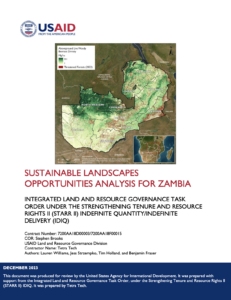 This report presents an assessment of land-based greenhouse gas (GHG) emissions mitigation opportunities in Zambia, with an aim to support decision-making for prioritizing sustainable landscape (SL) investments. The report emphasizes that effective land and resource governance is crucial for climate mitigation efforts, particularly in the forest sector. It combines biophysical analysis with an evaluation of policy and institutional frameworks to ensure that SL investments effectively support local systems and address governance challenges, thereby strengthening local ownership of interventions.
This report presents an assessment of land-based greenhouse gas (GHG) emissions mitigation opportunities in Zambia, with an aim to support decision-making for prioritizing sustainable landscape (SL) investments. The report emphasizes that effective land and resource governance is crucial for climate mitigation efforts, particularly in the forest sector. It combines biophysical analysis with an evaluation of policy and institutional frameworks to ensure that SL investments effectively support local systems and address governance challenges, thereby strengthening local ownership of interventions.
Zambia’s GHG emissions are predominantly land-based, with 85 percent emanating from agriculture, forestry, and land-use change. The land-use change and forestry sector alone accounted for 60.41 percent of the country’s emissions in 2020, while agriculture contributed an additional 24.24 percent. Two Natural Climate Solutions (NCS) assessments found that reforestation and avoided forest conversion were the mitigation pathways with the largest overall cost-effective potential – together these were estimated to represent 75.2 percent of the total land-based mitigation potential in Zambia. Enhancing tree cover in agricultural lands and improving fire management in savannas contribute an additional 14.1 percent together.
For each priority mitigation option, we reviewed national data and literature to ascertain their relevance and potential. We also reviewed major national development, climate, and forest strategies including Zambia’s Eight National Development Plan (2022 – 2026), the National Reducing Emissions from Deforestation and Forest Degradation (REDD+) Strategy and Investment Plan, and its Nationally Determined Contribution to understand national priorities in relation to potential mitigation options. We reviewed the policy and legal framework for forest management, incorporating governance analysis based on the World Resources Institute’s Governance of Forests Initiative Indicator Framework to review how these frameworks influence feasibility of implementation. The goal of incorporating this analysis is to ensure that SL investments support local systems for implementation of mitigation solutions including by addressing underlying governance challenges and strengthening local ownership of interventions.

